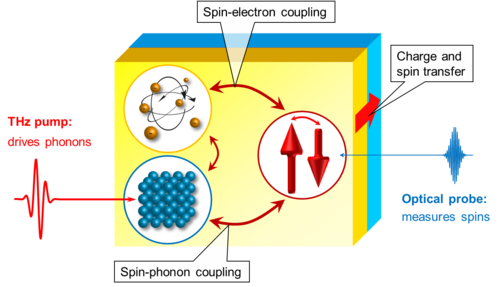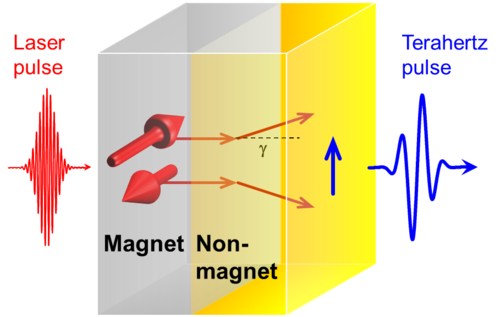Research
Our research program is focused on the following three challenges of the terahertz physics of quantum materials.
1. Reveal ultrafast elementary processes in quantum materials
Ultimately, we want to obtain a kind of movie that shows how electrons, spins and crystal lattice of a solid interact with each other on their natural (typically femtosecond) time scales and at their natural (typically THz) resonance frequencies. This idea is illustrated by the schematic in Figure 1.
We are particularly interested in the flow of angular momentum and energy. Examples of questions we want to answer are as follows:
- How does the vibrating crystal lattice (phonons) affect the state of the electrons or spins and vice versa (see Figure 1)?
- How can electron spin and orbital angular momentum be transported through a solid by light pulses (see Figure 2)?
- How do molecules in liquids and soft matter rotate due to strong pulsed electric fields?
2. Development of new spectroscopic tools
To answer the questions posed above, we develop new spectroscopic tools and methods, with a special focus on pulsed terahertz radiation with frequencies ranging from ~0.3 to 30 THz. We currently work on extending terahertz spectroscopy to quantum materials with magnetic order or other effects related to angular momentum. For instance, to reveal the coupling between crystal lattice and electron spins, we make use of the scheme in Figure 1: We use an intense THz pulse to resonantly excite optical phonons and probe the resulting impact on the spin system by a delayed optical probe pulse.
To probe and identify the inital steps of the ultrafast transport of electron spins, we recently developed the scheme shown in Figure 2. A femtosecond optical laser pulse is used to launch transport of electron spins (thick red arrows) from a ferromagnetic into a nonmagnetic metal layer. In the nonmagnetic metal, spin-up and spin-down electrons are deflected in opposite directions by an angle γ. This only recently discovered inverse spin Hall effect results in a transverse charge current (blue arrow), acting as a source of a THz electromagnetic pulse. Measurement of the THz electric field allows us to reconstruct of the spin transport dynamics.
Meanwhile, the approach of Figure 2 was extended to electron orbital angular momentum and to a platform that allows us to measure the spin conductance across a given material.
Finally, to interpret our experimental results, we work out simple toy models. For example, we have recently modeled the transport experiment above using spin transport equations and Maxwell's equations.
3. Applications
We explore our results for applications in fields such as spintronics (e.g., the ultrafast control of magnetic bits) and terahertz photonics. Here, the development of new emitters and detectors of terahertz radiation plays an important role since the terahertz range is still relatively difficult to access.
- For example, we used the spintronic structure of Figure 2 above to develop a novel emitter of terahertz radiation that is more efficient and broadband than established emitters. The short movie gives a preview of spintronic terahertz emitters at work in the lab.
- Recently, we were able to reverse the concept of Figure 2 and, thus, develop a detector of ultrabroadband terahertz electric fields.


